by Tom Gaylord
Writing as B.B. Pelletier
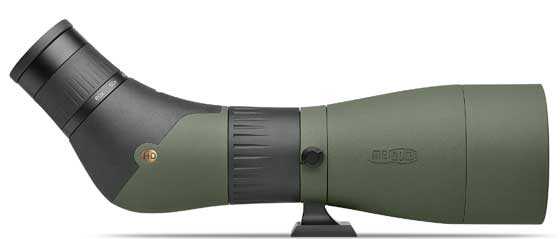
MeoPro HD 80 spotting scope from Meopta.
This report covers:
- Quality you can see
- Interview with the GM
- History
- Iron curtain falls
- Military and industrial applications
- The best optics you never heard of
- First test
- Test at 100 yards
- 200-yard test
- Second 200-yard test
- Evaluation so far
Sometimes I know how a report is going to go before I write the first word. This is such a time.
Quality you can see
I knew from looking through the Meopta binoculars at the 2016 SHOT Shot that this MeoPro HD 80 spotting scope was going to be good. And it is. How good will be the subject of this report.
Interview with the GM
I was able to arrange a phone interview with Meopta USA’s general manager and chief operating officer, Reinhard Seipp. He told me that he is an optical engineer, so he not only knows his company’s business profile — he knows the products and the technology that’s behind them. That is rare to find today. So many companies have businesspeople at the helm who haven’t much of a clue about the technical side of what their firm does. What I’m saying is when you want to talk about airguns, it’s nice to talk to an airgunner.
History
So, why haven’t most of us heard of Meopta? How did this monster optics firm with 2,500-plus employees and almost 1.5 million square feet of production space in New York and the Czech Republic come to be? I may not be an optics nerd, but as a shooter and photographer I do know the biggies. As it turns out, Meopta was right there among them all along, from their inception in 1933.
They started out in the ’30s making darkroom products like projectors and enlarging equipment. When the war came, they turned to military optics, and when the iron curtain went up in 1945 they found themselves on the communist side. They continued making military optics, and, since the communists had no free trade, they were under no pressure to control costs. The combination of meeting military specifications and a lack of competition meant they were free to turn out the finest optics they could, so that’s what they did. They made no consumer products at this time.
Iron curtain falls
When the Berlin Wall fell in 1989, the company had over 6,000 employees — all suddenly unemployed! Following the fall of communism during the Velvet Revolution, Czechoslovakia became the Czech Republic in 1993, and life became the “anything for a buck” ritual that West Germany had endured after the war. American entrepreneurs started marketing the company’s optics capability and soon found willing buyers among the world’s best-known optics houses — places like Leica and Hasselblad!
At first they sold lenses ground to specification, then optical subassemblies and packages. Finally they gained enough respect among their customer base that they were asked to make entire OEM products. If you are a user of ultra high-end optics you may already have used Meopta products without knowing it.
Military and industrial applications
Meopta continued to make optics for the military and also for industry. These are their two biggest divisions. For example, one of their industrial lines includes the high-speed optical scanners that check integrated circuits after manufacture. This work is extremely precise and requires the best optics — way beyond the level of normal consumer optics.
A lens-coating station can be purchased for around $60,000. Meopta has several of them that cost $1.5 million each. The difference is seen in the precision of their lenses. But most of us will never see their military or industrial products.
The best optics you never heard of
In 2007 the Meopta brand of sport optics was introduced to the American market. No wonder I never heard of them! I stopped learning new things in 1995!
Seriously, Meopta considers itself to be a boutique manufacturer of sport optics, and though they still manufacture high-end OEM products for others, they don’t compete with them. They rely on word of mouth rather than advertising, and on the reports written by outdoor sports writers. The MeoPro HD 80 spotting scope I am testing for you won the 2016 Outdoor Life Editor’s Choice award for spotting scopes.
They excel because they have that high-dollar precision machinery that can be used for sport optics during downtimes of industrial and military production. They don’t care about sales volume in the sport optics line — it’s not their major moneymaker. But when they pitch an industrial or military customer, it doesn’t hurt to have a stunning reputation for sporting optics. So they will not compete on price, yet the lack of an advertising budget coupled with the ability to use ultra-sophisticated optical manufacturing equipment means they can offer a superior product at a relative bargain price.
Their prices seem high to the uninitiated, but are actually a fraction of what optics of similar quality with sell for. The MeoPro HD 80 is particularly outstanding at a street price of $1500, because it sells for less than half of half what an equivalent Swarovski spotting scope costs, yet gives the same quality. Let’s test it!
First test
Test number one was to mount the scope and just see how it worked. My first image was of a head of rye grass at about 75 yards with an inchworm crawling up the head. That was with the scope set at 20 power. A good start!
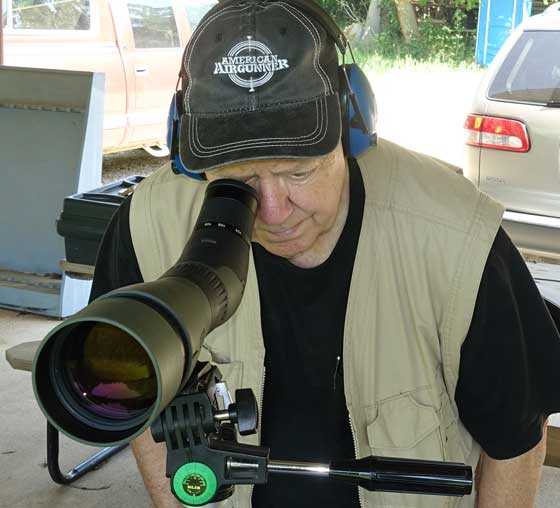
The elbow eyepiece makes the MeoPro HD 80 easy to use while standing. I’m viewing with my injured eye.
The image seen through the eyepiece is bright and large. I read one online customer rating of a different spotting scope that criticized it because the image appeared circular! Apparently this guy had never looked through a telescope before and was basing his judgement on what he saw on television. All the spotting scopes and binoculars I have ever seen give circular images.
The focus on the MeoPro is around the barrel of the scope and it is very slow. It’s easy to get a razor-sharp focus without a fine-tuning adjustment knob.
Also, the eye relief is long enough that your eye does not have to touch the eyepiece to see the whole image. That reduces the amount of vibration the scope will have, which at high magnification can be significant.
Test at 100 yards
Next I mounted the scope on my bench stand and focused on a target at 100 yards. I was shooting my AR-15 and I needed to confirm the zero because I haven’t shot it in over a year. It’s no trick seeing .22 caliber bullet holes at 100 yards. My 15-45X60 Burris can do that. And while I’m on the subject I would like to add that my Burris is just as clear andf sharp as it ever was. I thought it would suffer by comparison to the MeoPro, but it didn’t. It only goes to 45 power and has a 60mm objective lens that keeps it from seeing the smaller objects in dim light, but it’s still the pick of the litter for a spotting scope under $250.
Because the scope was on the bench stand, I uasd another feature of the MeoPro to turn the scope sideways so I could see through it while seated. The mount circles the barrel of the scope and allows it to be rotated aroind its axis 360 degrees, so there isn’t a position that isn’t comfortable for the user.
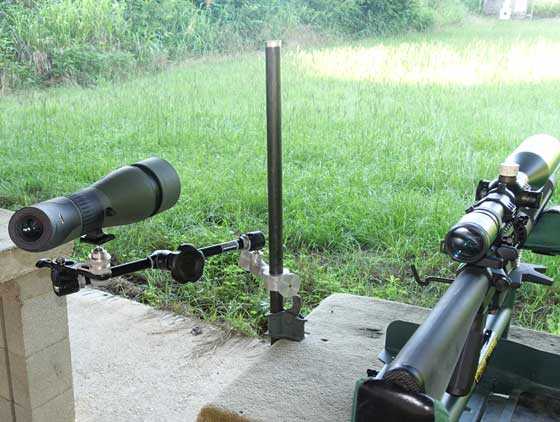
Here I have rotated the scope mount so it can sit sideways for seeing while seated.
I used this mount for my 100-yard testing and it worked fine, but the weight of the scope way out on the mount arm was at the limit. Any vibration was magnified.
200-yard test
This was the first acid test of the MeoPro scope. Now that the rifle’s zero was confirmed I wanted to see how it would do at 200 yards on 60-power. I had hoped to test it with bright sunlight on the target, but an old paper target on the backer board flapped up and shaded my target after I returned to the firing line. I would be looking at a target in the shade — an extreme acid test of Meopta’s optics!
The first bullet hole hit the bull at 4 o’clock and I could just barely make it out from 200 yards away. My Burris scope has no chance of equalling that — it just doesn’t have the power. But my shooting buddy, Otho, has a vintage 60-power Redfield spotting scope that is comparable. That obsolete scope is in high demand and often sells for $700 and up when it becomes available, because the optics are so good. But on this test that scope could not see the same bullet hole.
I shot three more times and could not see any of those three bullet holes through the MeoPro. So we are right at the scope’s limit — .22 caliber bullet holes in black target paper in the shade at 200 yards. Sometimes yes and other times no. With sunlight I think the odds of seeing would improve.
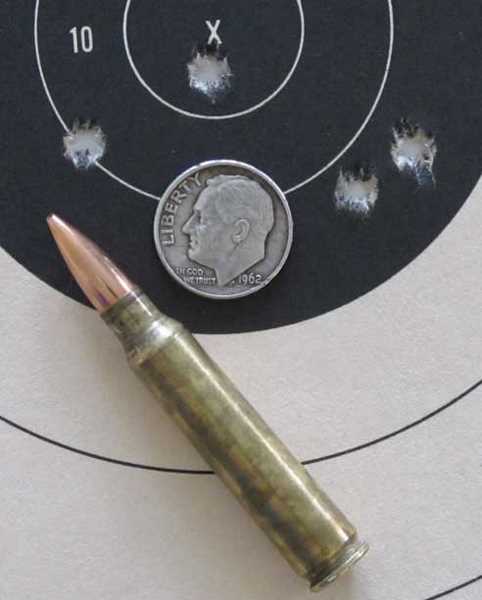
This target was shaded by another piece of paper. The hole at 4 o’clock (top one) was the only hole I could see through the scope at 200 yards. Four shots in this target.
I found that the scope mount I was using was just too flexible for this sensitive work, so I switched to a camera tripod. Once again the ability to position the scope so the eyepiece was in the perfect place proved to be a big bonus.
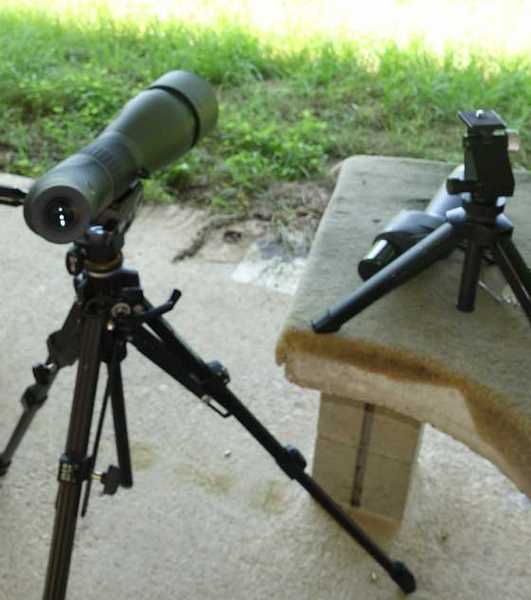
Mounting the MeoPro on a stout camera tripod steadied it a lot.
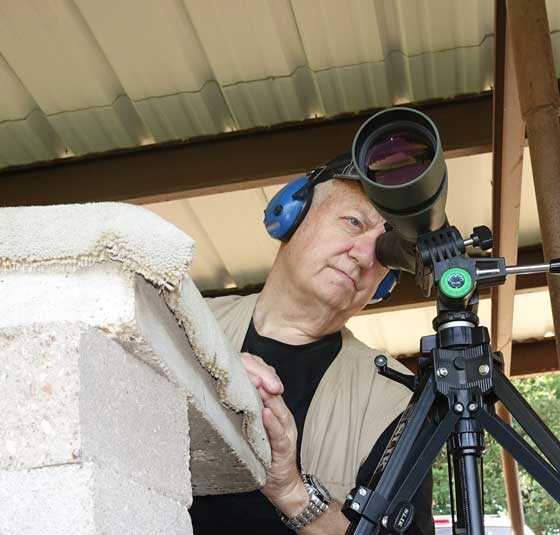
With the MeoPro mounted on the tripod it was easier to look without bumping the scope.
Second 200-yard test
I decided the second test needed to be shot at one of my square targets. These are mostly white, which makes the bullet holes easier to see, even with the Burris. But the first shot hit almost the center of one of the vertical black lines. I couldn’t see it with the Burris, but it was clear through the Meopta. The next shot hit the same line below the first and shot three went into the same hole as shot one. This was another test of the MeoPro. I could see that the hole from shots 1 and 3 was larger than shot 2, but with the Redfield at the same 60 power, it was not evident. So an ever-so-slight advantage goes to the MeoPro.
After 4 shots I had a sub-three-quarter-inch group working at 200 yards, so naturally shot number 5 opened it up to 1.65-inches and made me an honest man again. No reflection on the spotting cope — just my lousy luck.
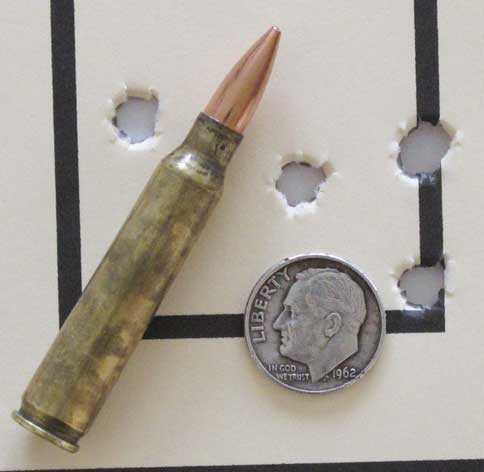
At 200 yards the first and third shots are in the top hole on the right line. Shot number two is below them and shot four is to their left. Shot five is even farther to the left, ruining what was trying to be a good group.
Evaluation so far
So far the MeoPro HD 80 is stacking up exactly as I anticipated. As I said, it doesn’t make my Burris look worse by comparison, but it does offer several advantages the Burris lacks. Meopta USA sent me something to adapt my iPhone 6S Plus to the scope, but it is incomplete. It’s just an eyepiece connector to mate with the spotting scope. It lacks a phone holder, so I haven’t been able to attach it yet. But I do plan to do that in this test. Maybe I can jury-rig something or find something commercial that I can adapt.
I plan to purchase the MeoPro for my business. The extra sharpness and other features will make things much easier for what I do, though I will not sell the Burris. I quit letting go of accurate guns and sharp optics a decade ago!
Before anyone mentions it — yes, Meopta does make rifle scopes. They are great low-light scopes, but unfortunately they do not adjust for parallax as close as the 10 meters demanded by airgunners. Meopta apparently is not aware of the sport of field target, where $2,000 for a competition scope is considered okay. If they ever do decide to get into the airgun world, look out Nightforce and Leupold!

BB– I used a Meopta enlarger in the 1962-63 school year. I had formed a photography club with some of my 7th grade pupils. About half of them had a variety of old 35mm cameras,( mostly the Argus). The other pupils liked my Minox sub-miniature cameras, but could not afford them. They bought the larger 16mm cameras. The school enlarger could only work with 35mm film. I traded my 03-a3 rifle to the owner of the photography store for the 16mm Meopta.. I made a mask for the smaller Minox negatives and I got prints equal in quality to the ones printed by Minox. I took Dave ( he owned the store and made the trade) To the 200 yd Blue Trail range in Conn. Poor Dave, he loved the rifle but could not take the recoil. After I married and moved to Long Island, (1967), we lost contact with each other. 36 years after the trade, I found my long lost 03-A3 at a gun show. I duplicated the loads that I had used when I had the rifle (180gr sierra match kings, 55 gr. 4831. ) The rifle hit dead center at 200 yards for the first and all the rest of the rounds that I fired that day. Yes, I had put a Williams peep sight on it in 1959, and it still was zeroed in for that load. It looked like it had spent 36 years in the closet. Lassie come home, well this is rifle come home! Ed
Ed
My dad was big into taking pictures and developing his 35 mm film. That was back in the mid 70’s when I was a teenager. He made our garage into a dark room. Use to love being out there helping him. He had a enlarger.
I don’t remember very well but I do remember him talking about the negatives and how the light and dark colors would reverse. I hope I’m saying that right. But definitely another one of those lost arts. Film developing.
BB
I enjoyed the report. All of it. And the history lesson about the company was interesting to read.
But something I noticed in the next to last picture when your looking through your the 80 spotting scope. Your using your left eye. I thought you were right eye dominant. At least that’s what I thought anyway. And I noticed in one of the other pictures your looking through the 80 with your right eye. You can look through the scope with either eye and be comfortable?
And you should of showed a picture of the phone adapter so we could see the back plate phone holders screw pattern of how it bolts to the adapter. That Iphone rifle scope phone adapter that I have been talking about also make a zero eye relief adapter for spotting scopes. You never know. They maybe who supplies the adapter for the 80 spotting scope your reviewing.
Here’s what I’m talking about for the spotting scope. What I’m getting at is their back plates might be able to be used for your spotting scope adapter.
http://www.iscope.com/#!ispotter/ck8n
GF1,
Yes, for that position my left eye worked better. I had to move less to see the image.
I am right-eye dominant, but I can shoot with either eye. That’s not a talent — I just trained myself.
When I get to the phone adaptor part there will be pictures. But you can go online now and see the same things.
I went to that website, but there is zero technical information about the product. You’re supposed to trust them that it always works with everything? I find that often isn’t the case.
I will contact them (never heard of them before your link) and see what they can do for me.
Thanks,
B.B.
BB
I got my supposedly correct back plate for my phone yesterday while I was at work. Checked it out some last night.
See where I just said (supposedly) correct back plate. It was about a 1/16″ short on legnth. My phone would clip in. I had to take and trimit of with a razor knife then sanded the edge straight with some sand paper laying on a table.
I read a couple reviews and they said they had the back plate to the Droid Maxx like I have and that’s what they did. I did it and it holds the phone good now. So happy about that. But I’m sure alot of other people would be sending the back plate back.
I mounted on my .25 Marauder last night when I got home from work. Centers up the adapter by looking out onto the garage door from the breezway. It was a little tricky getting the circle and reticle centered on my phone screen but got it. Then had to loosen the lock down screw to slide in and out to get the eye relief the best for the camera to see.
So I tryed using it last night just looking to see if I could locate my steel spinners and see the reticle. Couldn’t see nothing. Had to turn the flood lights on outside. Once I did that then I could see things but not like in the daylight. And I could see better when I zoomed in at 4 magnification on my phone camera. Then the circle and reticle was big.
What I’m seeing is the camera is now my eye looking into the scope. But now I have the option having my eye (the phone camera) to zoom in on what I see in the scope. Getting ready to go try it now with my targets out in the bright sun light and me in the shaded breezeway. I think it will be good in bright lighted situations. Will give a update in a bit.
And if you get ahold of them let us know if they have anything to say.
Oh and I think if a person had a hard plastic type phone protector with the rubber protector around it for their particular phone. It could be adapted to work. It should already have the hole in the back for the camera. You would only need to drill 3 holes that are about a 1/16″ diameter to mount it to the IScope adapter. Then you would for sure have the correct one for your phone.
Well the iscope works. Actually pretty good. I got some good short video’s about 20 seconds long.
But a problem. Not with the I iscope but with me trying to email and text the videos. I had to do a sped up version of each video that became 6 seconds long. And of course then it missed the true amount of time the spinners spun when hit. They would spin like 6 times around and the short video made it look like they maybe spun around once. But then I could at least email the videos. But still can’t text the videos. Keeps saying video is to long for text.
So I think I’m going to hook my phone to my laptop and create a file. Then I can email the full legnth video if I want. I think that should work.
And more things to learn again! Hope I get it figured out. The sending the video’s that is. The iscope adapter is working fine on the scope. I even got a few 100 yard video’s where you can see my 3 mildot hold over and the pellet making a cloud of dust dead on to the hold over when it hits. Pretty cool stuff.
Oh one more thing I forgot.
I can unclip my phone out of the iPhone adapder back plate and still look through my scope with the adapter still attached to the scope. Just like normal. I still have full veiw of the round scope picture and reticle even looking through the hole in the back plate.
So the adapter can stay on the scope. I can just clip my phone in if I want to take pictures or videos.
Update on the scope phone videos. The shorter high speed edited version is terrible. It takes away to much of the video. And adds some kind of music whole the video is playing. The sound of the gun shooting at the pellet hitting the target is muffled out by the music overriding it.
I have to figure out how to send the original legnth video’s that are real time with the correct sound. The other phone edited version is junk.
GF1,
Take your time and get it all figured out. Maybe the youngins’ could you give you a hand? Very cool that you are giving it a try though.
Chris USA
Think I got it. Uploaded the pictures on You Tube. Got it set on privacy. So only way to veiw will be with a link I provide.
Just now done it so will know in a bit I hope.
Chris USA
Yep it worked.
GF1,
At one time they listed an adaptor specficaly for an iPhone 4s (the model that I have) that was in an otter box case (the case that I use). Don’t know if they still list that specific combination any more since the 4s is getting to be obselete. But I thought that it was cool that they designed for cased phones.
Congratulations with your success with the videos.
Jim
Thanks Jim. I’m happy with it.
Sent BB and Buldawg and a few others some links from the YouTube video’s I uploaded. Maybe they will comment on them.
But the iscope adapter works great. Was very easy to shoot and film the shot. I just had problems learning how to send the video’s from my phone. I think it’s worth the money if you want to capture some of your shooting.
Think I’m going to get another adapter for my Talon SS so I can get some laser video’s and see how that works out. But yep I’m leaving the adapter always mounted to my .25 Marauder now. I can still shoot the gun fine with the adapter still mounted on the scope and the phone unclipped from the back plate. So happy about that too. But yep a cool product.
GF1,
Yep, it worked and worked well. I could only see something happen in 2 of the 4. All brief. You can here the gun fire and hear the pellet hit and see the spinners go spinning. The zoom looked I was standing maybe 20 yards away on what appeared to be 75 or 100 yd. shot.
Chris USA
The spinners were at 50-60 yards. And yep the zoom on the phone makes it like your right on top of the target.
It’s something different to mess with. And yep the YouTube video links were the original length real time video’s with real time sound. Those were the first videos I took with it so I kept them short. I think the longest was 20 seconds. But I can make them longer. So that was my beginner (grasshopper) video’s. So I know I’m going to get better at filming as I go. I hope. 🙂
when shooting with a rifle scope using my right eye I always use my left eye if I look thru a spotting scope being I think I am resting my right eye
B.B.,
Very nice report. It was a treat to see you out at the range and see some of your fine support equipment. And, while I can not speak from direct experience, any time you get sub-MOA, you are having a pretty good day. Nice shooting and nice groups.
Sounds like the Burris might be a good budget option.
I just looked at a Cabela’s catalog. There is one spotter only and it is a Cabela’s branded one. In the description,, it mentions MeoBright and MeoShield and EuroHD. Angled or straight choices, 20-70 X 82. 2300$. It is almost the spittin’ image of yours. If I were to guess, I will bet that it is made by Meopta. A little spot in the add noted that it is a Outdoor Life Great Buy..
Chris,
Meopta is the OEM for Cabelas.
B.B.
Good morning BB. You are looking healthy and prosperous. Glad to see it. I have been at the range with you and shot my Remington 700 in 30-06 at the 200 yard target. I even took photos of the results and still have them on my phone. My result was 8 rounds barely on paper, so I am REALLY impressed with your results. I don’t claim that the issue is with the firearm, but most likely a “user interface” problem. I have a problem getting a group like you shot at 100 yards. My 30-06 windage adjustment is currently maxed out so I am waiting for the delivery of new adjustable scope rings to arrive in the mail so I can return to the range and try my luck again. Next weekend I will shoot my trusty bolt action 7.62X39 that was a gift from you and Edie.
Later
Bob
Bob,
I was shooting my AR-15 that I half-built and half traded for. It is a 600-yard benchrest upper that costs me more than most ARs cost. This is the most accurate rifle I own and I load the cartridges so long that I have to load them one at a time — they won’t fit in a magazine.
I don’t like ARs as a rule, but this one is an exception. Believe me — I am not that good a shot! This is all the rifle.
B.B.
BB, the upper looks like a RRA. would I be correct? they make fantastically accurate ARs.
RPM,
The lower is Rock River. I built it to test Crosman’s .177 upper. I have no idea what the upper is. I got it in a deal for the Saber Defense bull barrel.
B.B.
B.B.,
I’m envous of your for the angled eyepiece you have on Meopta. My antique Zeiss spotting scope lacks the angled bend for the eyepiece — I wish it had one. The eyepiece runs parallel. It is not in line with the tube; however, as the scope has a round enclosure for the refractive prism(s?) and the eyepiece is on the other side of the circle. One nice feature it has (in addition to having two different eyepieces, one for lesser magnification and the other for much greater magnification) is it actually has iron sights on top like a rifle. That makes it incredibly easy for me to aim. Imagine, sights on top of a scope!
Michael
Michael,
Many good scopes ()not astronomical scopes though) have open sights for rough alignment because the magnification makes it hard to find the target. Astronomical scopes have small guide scopes for the same purpose.
You won’t see then on cheap spotting scopes though. The MeoPro HD 80 doesn’t have one because it rotates around its axis 360 degrees. The sights would almost never be visible.
B.B.
BB
Loved this report. The history lesson should be required reading for all people running for any office. Also the background of the General Manager is refreshing. Folks, have you rented a car or gone on a cruise trip lately?
It is good to know you are seeing well with damaged eye. Keep up your good work. I read your report first thing everyday.
Decksniper
I never new how much I would use a spotting scope until a friend gave me a nice one. I strongly recommend anyone who is serious about shooting buys the best they can afford.
I have a sighting question. I shoot mostly indoors at 10 M. I use a 6 oclock hold for my pistols. I just bought an HW30S. It has a post with small bead front sight. I am using a center hold because the bead is smaller at 10M than the center white of the target. Is this going to allow me to shoot my best or should I adjust it to a 6 hold also?
Thanks
A357man,
I use a 6 o’clock hold to see the bead against the target. If it’s centered there needs to be bright light on the bead.
B.B.
B.B.
Good to know. I have been trying that method recently. Trying to make a perfect sight picture that looks like an “8”
So, another utterly and totally unrelated question for you, Tom.
I’m pondering a hand pump for my Talon SS, to work in conjunction with my SCUBA tank. I figure it’ll be just as quick and easy to hand-pump to top up after five or six shots (the usual I fire when I’m walking around toppling starlings this time of year) as it would be to use the tank, and it’ll save my bulk air for major fills when I’m target shooting and drawing the gun well down.
So, I can get a refurbished AirForce pump for $140, or a new Hill Mk4 for $290. Is the Hill enough of an improvement over the AirForce to be worth double the money? If it is, I’ll go for it. If not, I’ll save the money and use it for the first bit of saving for a better optic than my Muller Eradicator.
Komitadjie,
Hill pumps are good, but mine finally broke. I now use a Pyramyd AIR pump that is as good as any of them, I think.
And your plan sounds solid to me.
B.B.
With that in mind, then, I think I’ll go for the refurbished AirForce pump and save the extra $140 for a Hawke or similar scope. Thanks, Tom, I appreciate the advice!
For what it’s worth…
About 40 years ago…
I purchased Meopta enlarger and it was installed in the minuscule kitchen closet, under the stairs leading to the upstairs apartment. The plan was to use this one until I could afford a “real” and “good” enlarger to further my newish pro-photography business. Guess what? It turned out the quality of the Meopta easily matched…even exceeded…the “Best-Quality” enlargers.
I used it for 35mm for decades. Larger and medium format was used by other brands (‘cuz I was unaware that Meopta made larger) but it labored on until replaced, eventually, by inkjet and digital printing. (Too many wine glasses tipped over into the developer tray in the dark. Ruins the PH and stains the prints.)
But the general quality of construction of the Meopta product was superb. Several photo businesses and at least one camera store later, I still rather miss it, (sold in a weak moment. Really liked that hammer-tone silver paint job.)
Probably the most important part of this short Meopta story is the life lesson learned…is to buy the best.
It removes the issue of of being held back by your tools. Life is short, and you deserve the best. Buy the FWB P44, the Leica, the Python, the…well, you already know what “that” item is. The least you’ll get out of it is knowing you can’t blame the tool, you just need to improve your technique:):):)
(Well, and maybe also your hold, trigger pull, stance, glasses, feng shui, hearing, water-coloring talents, situational awareness, sweaty-environmental summer Texas temp control, too-tight whitey-tighties, and all the rest:):):)
All around interesting. I thought the Communist command economy was supposed to make people less motivated and productive, but here it seems to have had an opposite effect. And I agree that the rotating, angled eye piece is a great feature and the one thing that I miss on my new spotting scope. Also, the clarity of my scope gives me a new appreciation of how important vision is. With the new scope, I feel like I can almost reach out and touch the target 100 miles away, and that kind of acuity can only help your shooting. Still $1500 seems like a lot of money for a scope.
Fido3030, thanks for your note and how appropriate that today’s post featured an AR. Using a slow twist rate to destabilize a bullet and make it prone to tumble sounds like a brilliant engineering idea, but it didn’t work out in practice. The tumbling was very unpredictable and dependent on the density of the target. It was found to be impossible to produce some of the glowing field reports about bullet effect. And in Arctic temperatures, the accuracy was consistently appalling. No doubt this inspired the Marines for the A2 version to use a heavier bullet and increase the twist rate. This resulted in accuracy that probably nobody anticipated, but it removed most of the damage due to tumbling. Yet another paradox of the AR system is that while originally designed and hyped for its bullet performance, it has become notorious for its lack of lethality.
For tumbling, it seems to me that the Russians had a better idea with their 5.45X39mm round. They created tumbling with a flat space in the bullet that allowed a piece of metal to move forward on impact. The change in weight destabilized the bullet without interfering with ballistics as twist rate does. So, you get a very low-recoiling round with devastating performance. However, the low energy pays a price in ballistics and performance. Since I am only interested in trajectory for target shooting, the .223 works fine for me.
Matt61
Matt 61
Thanks! Lots of info new to me.
Fido3030
B.B.,
Thanks for the above info. I may have to give Cabela’s brand a consider.
Which brings me to my question,…. if a scope has a etched glass reticle, is there any chance,… whatsoever,… that it will be damaged by an airgun? As I understand it, it was the spring supported wire reticles that were the issue on trashing a high end firearm scope
I would not expect a manufacturer to say that a scope is airgun rated when you are paying 1500$,… or even 500$. I think that the higher end scopes are considered firearm intended but maybe they would do just as well on a airgun.
I will bet than more than a few people are wondering the same thing.
Thanks, Chris
Chris,
When I asked Leupold execs at the SHOT Show many years ago if they planned to make an airgun scope, they replied, “No, we do not.” The Thomas family was in the booth and was modifying Leupold scopes for airguns in those days (late ’90s).
Today I have told you that Meopta scopes don’t adjust for parallax close enough for airgunners. Are their scopes rugged enough? I can’t say for sure, but probably so.
Leapers “guilted” the upscale scope makers into building their scopes rugged enough for airguns when they decided that spring gun ruggedness would be their corporate standard. As a result, UTG scopes have been torture-tested on elephant rifles and survived.
Any scope can break — make no mistake about that. But today’s scopes are far more rugged than they were 20 years ago.
As for etched glass — they have nothing to break! You can’t break a line etched in glass, unless you break the glass, itself. Wire reticles do still break on some airguns.
There is no spring supporting the wire in a reticle. Are you confusing them with the return springs(s) in the erector tube?
B.B.
B.B.,
It has been awhile since I have delved into scope info.,…. but I thought that the wire cross hairs were supported only one way,… and thus could not take the forward punch, of say a springer. As for the erector tube springs, they simply hold the tube under pressure in all directions and translate what the E/W turrets are set at. I think there are 2 types, coil and leaf, and I suppose they could break, but I really thought that the wire cross hairs were the issue and how and in what direction they were supported in.
I guess the bottom line is what makes a scope airgun worthy and more important, what makes a scope (not) air gun worthy. If I run up on an offer for a 1500$ scope for 500$, let’s say,… do I buy it or not? I am thinking yard sales, fire arm shooter friends, auctions, etc.
I hope that clarifies my question,…. thanks,…. Chris
Chris,
It’s the erector tube that is supported, and your information is about 20 years out of date. Except for a few ultra-cheapie scopes, most manufacturers are now supporting the erector tube in both directions. Like I said before, Leapers guilted them into doing it. Companies like Leupold followed Leapers’ course and just reinforced all their scopes, rather than deal with the problems brought by spring-piston airguns.
The reticle wires or etched glass lenses are held inside the erector tube.
I would avoid yard-sale and gun-show scopes like the plague. That’s where people get rid of the scopes that don’t work. I’ve done it and I know others who do it as well.
B.B.
B.B.,
Sorry, busy with the usual getting ready for work the next day,…. stuff. As for the Meopta focusing low, I would use anything like that on the M-rod at 50-100 yards, would they be good enough for that?
As for etched glass, yes, I figured there was nothing to break,…. that is why I thought that if a higher end firearm scope had etched glass reticle,… that it would be good for air guns. But, perhaps there is something that I am over looking?
A side thought,…. I find hard to believe that anything that could take the thump of a firearm could break under an air gun. It does though, as the stories I have read here in my short time here,…illustrate,… of mounting a fine high end scope on an air gun, only to trash it in no short order.
Chris,
I think most Meopta scopes adjust to 50 yards, minimum. Perhaps they have one that goes down to 25 yards.
B.B.
B.B.,
Me,… again,…. your comment,…”there is no spring supporting the wire reticle”,…… now (I am) confused. ;(
That did seem a bit odd, but ok,… that is what I thought it was.
I guess your comment, (that I finally absorbed),… leads me back to the question of what makes a high end scope air gun worthy, or not? Maybe it is the erector springs that bust after all?
Chris,
No, the reticle wires DO break from recoil. They just aren’t held in by springs.
The thing about the erector tube spring is when the tube is adjusted too high or too far to the right, the springs relax and allow the tube to move under recoil. That give you something people are calling scope shift.
B.B.
B.B.,
Thank you for all of the replies. I am aware of the too far up and too far out issue. And while that would cause scope shift, that is different from a broken scope, as it can be remedied. Thanks for the clarification on the wire reticles. I am a big fan of the lighted etched glass reticles for my low light, heavy woods situation.
Tom,
I would like to thank you for something. I own 15 springers all better European and love them, they are like my children. Ask which one I like the best and it’s difficult, like what’s your favorite child. A couple of weeks ago I read one of your old articles on your FWB150. Well I have a new child a great 150 owned by a former USA competitor. I shot it today and what a joy. Cock the gun with my little finger and absolutely no recoil. I did run into a problem five shots through the same exact hole. I was sure that shots were going off target so I aimed a little off the other holes and that’s where it went. Never felt a gun so easy to hold. Not really a fifty yard gun and even forty is tuff, I could out run the pellet but thirty or less blows me away. Only 6.7 fpe of energy but I now have a favorite child. Thanks for your great honest reviews and keep writing.
Paul53,
You have just written the reason I write this blog. I write it so people like you can experience the really good things in airgunning. Things I have experienced and want to pass along.
Thanks for the feedback,
B.B.